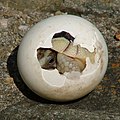Turtle
Article about turtles
Turtles are reptiles of the order Testudines, characterized by a bony or cartilaginous shell that acts as a shield. The order includes both extant and extinct species, with the earliest known turtles dating back to the Triassic period, around 220 million years ago. Turtles are ectothermic, or cold-blooded, and are found in a variety of environments, from terrestrial to freshwater and marine habitats.
Anatomy and Physiology
Turtles have a unique body plan that includes a shell composed of a carapace (dorsal part) and a plastron (ventral part). The shell is made up of bony plates covered by scutes, which are keratinous scales. Unlike other reptiles, turtles cannot expand their chest to breathe; instead, they use special muscles to move their internal organs and create negative pressure to inhale.
Shell
The turtle shell is a complex structure that provides protection and support. It is formed by the fusion of ribs and vertebrae, which are covered by scutes. The shell's shape and size vary among species, adapted to their specific environments and lifestyles.
Respiration
Turtles have adapted various methods of respiration. While most breathe air through lungs, some species can absorb oxygen through their skin or cloaca, especially when submerged in water for extended periods.
Ecology and Behavior
Turtles occupy diverse ecological niches. Some are strictly aquatic, like the Green sea turtle, while others, such as the Box turtle, are primarily terrestrial. Turtles are generally omnivorous, with diets ranging from plants and algae to invertebrates and small vertebrates.
Reproduction
Turtles lay eggs, which they bury in sand or soil. The temperature of the nest can determine the sex of the hatchlings, a phenomenon known as temperature-dependent sex determination. After laying eggs, most female turtles do not provide parental care.
Migration
Many turtle species, particularly sea turtles, undertake long migrations between feeding and nesting grounds. These migrations can span thousands of kilometers and are guided by environmental cues such as ocean currents and the Earth's magnetic field.
Conservation
Turtles face numerous threats, including habitat destruction, pollution, climate change, and poaching for their meat and shells. Conservation efforts focus on habitat protection, legal protection, and captive breeding programs to ensure the survival of endangered species.
Cultural Significance
Turtles have been featured in various cultural myths and legends. In some cultures, they symbolize longevity and wisdom. The Kurma avatar of the Hindu god Vishnu is depicted as a turtle, representing stability and support.
Related pages
References
<references group="" responsive="1"></references>
Gallery
-
Olive Ridley Sea Turtle
-
Florida Box Turtle
-
Turtle Skeleton Cross-section
-
Turtle Shell Development
-
Green Sea Turtle
-
Red Eared Slider
-
Indian Softshell Turtle
-
Snapping Turtle
-
Basking Cooter Turtles
-
Green Sea Turtle Grazing
-
Oblong Turtle
-
Crested Caracara Eating a Turtle
-
Tortoise Snap
-
Three-toed Box Turtle
-
Snapping Turtle
-
Tortoise Hatchling
-
Origin of Turtle Body Plan
-
Haeckel's Chelonia
-
Zoology of Egypt
-
Geometric Tortoise
-
Deinosuchus
-
Spot-billed Pelican
-
Pig-nosed Turtle
Turtle
-
Turtle
-
Turtle
-
Turtle
-
Turtle
-
Turtle
-
Turtle
-
Turtle
-
Turtle
-
Turtle
-
Turtle
-
Turtle
-
Turtle
-
Turtle
-
Turtle
-
Turtle
-
Turtle
-
Turtle
-
Turtle
-
Turtle
-
Turtle
-
Turtle
-
Turtle
Ad. Transform your life with W8MD's Budget GLP-1 injections from $75


W8MD offers a medical weight loss program to lose weight in Philadelphia. Our physician-supervised medical weight loss provides:
- Weight loss injections in NYC (generic and brand names):
- Zepbound / Mounjaro, Wegovy / Ozempic, Saxenda
- Most insurances accepted or discounted self-pay rates. We will obtain insurance prior authorizations if needed.
- Generic GLP1 weight loss injections from $75 for the starting dose.
- Also offer prescription weight loss medications including Phentermine, Qsymia, Diethylpropion, Contrave etc.
NYC weight loss doctor appointmentsNYC weight loss doctor appointments
Start your NYC weight loss journey today at our NYC medical weight loss and Philadelphia medical weight loss clinics.
- Call 718-946-5500 to lose weight in NYC or for medical weight loss in Philadelphia 215-676-2334.
- Tags:NYC medical weight loss, Philadelphia lose weight Zepbound NYC, Budget GLP1 weight loss injections, Wegovy Philadelphia, Wegovy NYC, Philadelphia medical weight loss, Brookly weight loss and Wegovy NYC
|
WikiMD's Wellness Encyclopedia |
| Let Food Be Thy Medicine Medicine Thy Food - Hippocrates |
Medical Disclaimer: WikiMD is not a substitute for professional medical advice. The information on WikiMD is provided as an information resource only, may be incorrect, outdated or misleading, and is not to be used or relied on for any diagnostic or treatment purposes. Please consult your health care provider before making any healthcare decisions or for guidance about a specific medical condition. WikiMD expressly disclaims responsibility, and shall have no liability, for any damages, loss, injury, or liability whatsoever suffered as a result of your reliance on the information contained in this site. By visiting this site you agree to the foregoing terms and conditions, which may from time to time be changed or supplemented by WikiMD. If you do not agree to the foregoing terms and conditions, you should not enter or use this site. See full disclaimer.
Credits:Most images are courtesy of Wikimedia commons, and templates, categories Wikipedia, licensed under CC BY SA or similar.
Translate this page: - East Asian
中文,
日本,
한국어,
South Asian
हिन्दी,
தமிழ்,
తెలుగు,
Urdu,
ಕನ್ನಡ,
Southeast Asian
Indonesian,
Vietnamese,
Thai,
မြန်မာဘာသာ,
বাংলা
European
español,
Deutsch,
français,
Greek,
português do Brasil,
polski,
română,
русский,
Nederlands,
norsk,
svenska,
suomi,
Italian
Middle Eastern & African
عربى,
Turkish,
Persian,
Hebrew,
Afrikaans,
isiZulu,
Kiswahili,
Other
Bulgarian,
Hungarian,
Czech,
Swedish,
മലയാളം,
मराठी,
ਪੰਜਾਬੀ,
ગુજરાતી,
Portuguese,
Ukrainian






















